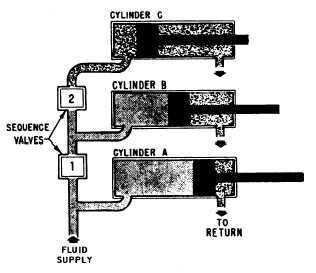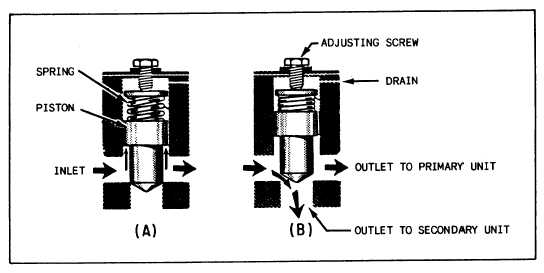Figure 6-15.—Installation
SEQUENCE VALVES
of sequence valves.
Sequence valves control the sequence of
operation between two branches in a circuit; that
is, they enable one unit to automatically set
another unit into motion. An example of the use
of a sequence valve is in an aircraft landing gear
actuating system.
In a landing gear actuating system, the landing
gear doors must open before the landing gear
starts to extend. Conversely, the landing gear must
be completely retracted before the doors close. A
sequence valve installed in each landing gear
actuating line performs this function.
A sequence valve is somewhat similar to a
relief valve except that, after the set pressure has
been reached, the sequence valve diverts the fluid
to a second actuator or motor to do work in
another part of the system. Figure 6-15 shows an
installation of two sequence valves that control
the sequence of operation of three actuating
cylinders. Fluid is free to flow into cylinder A.
The first sequence valve (1) blocks the passage of
fluid until the piston in cylinder A moves to the
end of its stroke. At this time, sequence valve 1
opens, allowing fluid to enter cylinder B. This
action continues until all three pistons complete
their strokes.
There are various types of sequence valves.
Some are controlled by pressure and some are
controlled mechanically.
Pressure-Controlled Sequence Valve
The operation of a typical pressure-controlled
sequence valve is illustrated in figure 6-16. The
opening pressure is obtained by adjusting the
tension of the spring that normally holds the
piston in the closed position. (Note that the top
part of the piston has a larger diameter than the
lower part.) Fluid enters the valve through the
inlet port, flows around the lower part of the
piston and exits the outlet port, where it flows to
the primary (first) unit to be operated (fig. 6-16,
view A). This fluid pressure also acts against the
lower surface of the piston.
Figure 6-16.—Operation of a pressure-controlled sequence valve.
6-11



